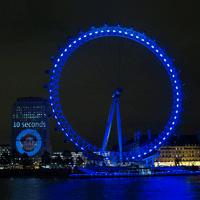|
|
|
| Policy | |
Diabetes communities unite to celebrate World Diabetes Day November 1413 November 2007 Diabetes currently affects 246 million people globally. For all of them and the many millions more at risk, November 14, 2007 is a highly significant date as it marks the first United Nations-observed World Diabetes Day. World Diabetes Day is the primary global awareness campaign of the diabetes world. It was introduced by the International Diabetes Federation (IDF) and the World Health Organization in response to concern over increasing numbers of people with diabetes around the world. The date marks the birthday of Frederick Banting who, along with Charles Best, first conceived the idea which led to the discovery of insulin in 1921. With the passage of the United Nations' World Diabetes Day Resolution in December 2006, November 14 has now become a United Nations-observed day.
The London Eye (see right) was lit up in blue last Friday to mark the beginning of celebrations. It was the first of some of the world’s most iconic monuments to be illuminated in blue. It will continue to be lit up every night up to and including World Diabetes Day on Wednesday, along with the nearby Shell Tower on to which moving images and text are being projected. Other monuments to be illuminated include the Empire State Building, the Leaning Tower of Pisa, the Eiffel Tower, the Sydney Opera House, the Tokyo Tower, Niagara Falls, the Burj Al Arab in Dubai, Christ the Redeemer in Rio de Janeiro, the Bosphorus Bridge in Istanbul, the Library of Alexandria in Egypt, and the world’s tallest building, Taipei 101, in Taiwan. At the United Nations there will be a human blue circle on the
grounds — the blue circle is the global symbol for diabetes — a 246-step
march from the UN down 1st Avenue in honour of people with diabetes
worldwide; and a diabetes education rally that will include musical
performances and celebrity appearances. Further information The International Diabetes Federation: www.idf.org |
